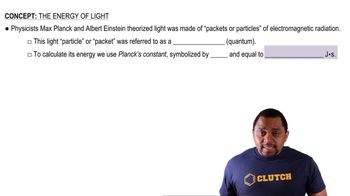Here are the essential concepts you must grasp in order to answer the question correctly.
Photon Energy and Wavelength Relationship
The energy of a photon is inversely related to its wavelength, described by the equation E = hc/λ, where E is energy, h is Planck's constant, c is the speed of light, and λ is wavelength. This relationship allows us to calculate the wavelength of a photon when its energy is known, and vice versa.
Recommended video:
Frequency-Wavelength Relationship
Visible Spectrum and Color Perception
The visible spectrum is the portion of the electromagnetic spectrum that can be detected by the human eye, ranging from approximately 400 nm (violet) to 700 nm (red). The color perceived by an object is determined by the wavelengths of light it reflects; if a complex absorbs light at a specific wavelength, it will appear as the complementary color of that wavelength.
Recommended video:
Planck's Constant
Planck's constant (h) is a fundamental constant in quantum mechanics, valued at approximately 6.626 x 10⁻³⁴ J·s. It plays a crucial role in the quantization of energy levels and is essential for calculations involving photon energy and wavelength, linking the microscopic world of photons to macroscopic observations of light.
Recommended video:
Photons and Planck's Constant

 Verified step by step guidance
Verified step by step guidance

